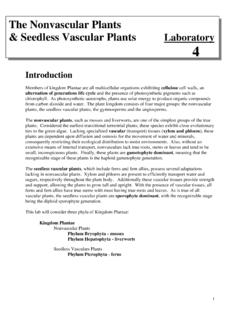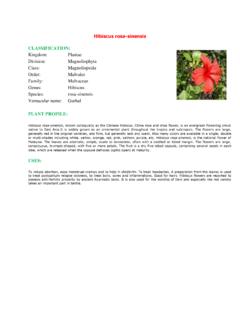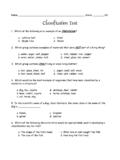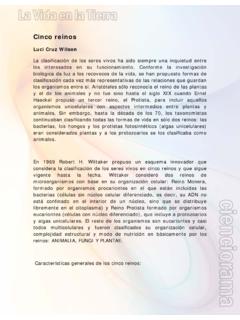Transcription of C 2 IOLOGICAL CLASSIFICATION - National Council of ...
1 16 BIOLOGY. CHAPTER 2. BIOLOGICAL CLASSIFICATION . Kingdom Monera Since the dawn of civilisation, there have been many attempts to classify living organisms. It was done instinctively not using criteria that were Kingdom Protista scientific but borne out of a need to use organisms for our own use for Kingdom Fungi food, shelter and clothing. Aristotle was the earliest to attempt a more Kingdom plantae scientific basis for CLASSIFICATION . He used simple morphological characters to classify plants into trees, shrubs and herbs. He also divided animals Kingdom into two groups, those which had red blood and those that did not.
2 Animalia In Linnaeus' time a Two Kingdom system of CLASSIFICATION with Viruses, Viroids plantae and Animalia kingdoms was developed that included all plants and Lichens and animals respectively. This system was used till very recently. This system did not distinguish between the eukaryotes and prokaryotes, unicellular and multicellular organisms and photosynthetic (green algae). and non-photosynthetic (fungi) organisms. CLASSIFICATION of organisms into plants and animals was easily done and was easy to understand, but, a large number of organisms did not fall into either category. Hence the two kingdom CLASSIFICATION used for a long time was found inadequate.
3 A need was also felt for including, besides gross morphology, other characteristics like cell structure, nature of wall, mode of nutrition, habitat, methods of reproduction, evolutionary relationships, etc. CLASSIFICATION systems for the living organisms have hence, undergone several changes over time. Though plant and animal kingdoms have been a constant under all different systems, the understanding of what groups/organisms be included under these kingdoms have been changing; the number and nature of other kingdoms have also been understood differently by different scientists over time.
4 2015-16(19/01/2015). BIOLOGICAL CLASSIFICATION 17. TABLE Characteristics of the Five Kingdoms Five Kingdoms Characters Monera Protista Fungi plantae Animalia Cell type Prokaryotic Eukaryotic Eukaryotic Eukaryotic Eukaryotic Cell wall Noncellulosic Present in Present Present (Polysaccharide some (without (cellulose) Absent + amino acid) cellulose). Nuclear Absent Present Present Present Present membrane Body Cellular Cellular Multiceullar/ Tissue/ Tissue/organ/. organisation loose tissue organ organ system Autotrophic (chemosyn- Autotrophic Heterotrophic Autotrophic Heterotrophic thetic and (Photosyn- (Saprophytic/ (Photosyn- ( H o l o z o i c /.)))))
5 Mode of photosynthetic) thetic) and Parasitic) thetic) Saprophytic nutrition and Hetero- Hetero- etc.). trophic (sapro- trophic phytic/para- sitic). Whittaker (1969) proposed a Five Kingdom CLASSIFICATION . The kingdoms defined by him were named Monera, Protista, Fungi, plantae and Animalia. The main criteria for CLASSIFICATION used by him include cell structure, thallus organisation, mode of nutrition, reproduction and phylogenetic relationships. Table gives a comparative account of different characteristics of the five kingdoms. Let us look at this five kingdom CLASSIFICATION to understand the issues and considerations that influenced the CLASSIFICATION system.
6 Earlier CLASSIFICATION systems included bacteria, blue green algae, fungi, mosses, ferns, gymnosperms and the angiosperms under Plants'. The character that unified this whole kingdom was that all the organisms included had a cell wall in their cells. This placed together groups which widely differed in other characteristics. It brought together the prokaryotic bacteria and the blue green algae with other groups which were eukaryotic. It also grouped together the unicellular organisms and the multicellular ones, say, for example, Chlamydomonas and Spirogyra were placed together under algae.
7 The CLASSIFICATION did not differentiate between the heterotrophic group fungi, and the autotrophic green plants, though they also showed a characteristic difference in their walls composition . the fungi had chitin in their walls while the green plants had a cellulosic 2015-16(19/01/2015). 18 BIOLOGY. cell wall. When such characteristics were considered, the fungi were placed in a separate kingdom Kingdom Fungi. All prokaryotic organisms were grouped together under Kingdom Monera and the unicellular eukaryotic organisms were placed in Kingdom Protista. Kingdom Protista has brought together Chlamydomonas, Chlorella (earlier placed in Algae within Plants and both having cell walls) with Paramoecium and Amoeba (which were earlier placed in the animal kingdom which lack cell wall).
8 It has put together organisms which, in earlier classifications, were placed in different kingdoms. This happened because the criteria for CLASSIFICATION changed. This kind of changes will take place in future too depending on the improvement in our understanding of characteristics and evolutionary relationships. Over time, an attempt has been made to evolve a CLASSIFICATION system which reflects not only the morphological, physiological and reproductive similarities, but is also phylogenetic, , is based on evolutionary relationships. In this chapter we will study characteristics of Kingdoms Monera, Protista and Fungi of the Whittaker system of CLASSIFICATION .
9 The Kingdoms plantae and Animalia, commonly referred to as plant and animal kingdoms, respectively, will be dealt with separately in chapters 3 and 4. KINGDOM MONERA. Bacteria are the sole members of the Kingdom Monera. They are the most abundant micro-organisms. Bacteria occur almost everywhere. Hundreds of bacteria are present in a handful of soil. They also live in extreme habitats such as hot springs, deserts, snow and deep oceans where very few other life forms can survive. Many of them live in or on other organisms as parasites. Bacteria are grouped under four categories based on their shape: the spherical Coccus (pl.)
10 : cocci), the rod-shaped Bacillus (pl.: bacilli), the comma-shaped Vibrium (pl.: vibrio) and the spiral Spirillum (pl.: spirilla). (Figure ). Spore Flagellum Cocci Spirilla Bacilli Vibrio Figure Bacteria of different shapes 2015-16(19/01/2015). BIOLOGICAL CLASSIFICATION 19. Though the bacterial structure is very simple, they are very complex in behaviour. Compared to many other organisms, bacteria as a group show the most extensive metabolic diversity. Some of the bacteria are autotrophic, , they synthesise their own food from inorganic substrates. They may be photosynthetic autotrophic or chemosynthetic autotrophic.















